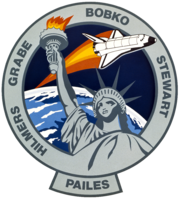STS-51-J
This article includes a list of general references, but it lacks sufficient corresponding inline citations. (May 2008) |
 Maiden launch of Atlantis; in-flight photography on this Department of Defense mission is limited | |
| Mission type | Satellite deployment |
|---|---|
| Operator | NASA, Department of Defense |
| COSPAR ID | 1985-092A |
| SATCAT no. | 16115 |
| Mission duration | 4 days, 1 hour, 44 minutes, 38 seconds |
| Distance travelled | 2,707,948 kilometres (1,682,641 mi) |
| Orbits completed | 64 |
| Spacecraft properties | |
| Spacecraft | Space Shuttle Atlantis |
| Landing mass | 86,400 kilograms (190,400 lb) |
| Payload mass | 19,968 kilograms (44,022 lb) |
| Crew | |
| Crew size | 5 |
| Members | |
| Start of mission | |
| Launch date | 3 October 1985, 15:15:30 UTC |
| Launch site | Kennedy LC-39A |
| End of mission | |
| Landing date | 7 October 1985, 17:00:08 UTC |
| Landing site | Edwards Runway 23 |
| Orbital parameters | |
| Reference system | Geocentric |
| Regime | Low Earth |
| Perigee altitude | 475 kilometres (295 mi) |
| Apogee altitude | 484 kilometres (301 mi) |
| Inclination | 28.5 degrees |
| Period | 94.2 min |

 L-R: Stewart, Hilmers, Bobko, Pailes, Grabe | |
STS-51-J was the 21st NASA Space Shuttle mission and the first flight of Space Shuttle Atlantis. It launched from Kennedy Space Center, Florida, on 3 October 1985, carrying a payload for the U.S. Department of Defense, and landed at Edwards Air Force Base, California, on 7 October.
Crew
| Position | Astronaut | |
|---|---|---|
| Commander | Karol J. Bobko Third and last spaceflight | |
| Pilot | Ronald J. Grabe First spaceflight | |
| Mission Specialist 1 | David C. Hilmers First spaceflight | |
| Mission Specialist 2 | Robert L. Stewart Second and last spaceflight | |
| Payload Specialist 1 | William A. Pailes, MSE Only spaceflight | |
Backup crew
| Position | Astronaut | |
|---|---|---|
| Payload Specialist 1 | Michael W. Booen, MSE First spaceflight | |
Crew notes
Before William Pailes was assigned to the STS-51-J flight, Richard M. Mullane was rumored to have been assigned as Mission Specialist 3 on his second trip to space.
Mission summary


STS-51-J launched on 3 October 1985, at 11:15 EDT, from Launch Pad 39A at the Kennedy Space Center. The launch was delayed by 22 minutes and 30 seconds due to a problem with a main engine liquid hydrogen prevalve close remote power controller; the controller was showing a faulty "on" indication.
The mission was the second shuttle flight totally dedicated to deploying a Department of Defense payload, after STS-51-C. Its cargo was classified, but it was reported that two (USA-11 and USA-12) DSCS-III (Defense Satellite Communications System) satellites were launched into stationary orbits by an Inertial Upper Stage. The DSCS satellites used X-band frequencies (8/7 GHz). Each DSCS-III satellite had a design life of ten years, although several of the DSCS satellites have far exceeded their design life expectancy.
The mission was deemed successful. After a flight lasting 4 days, 1 hour and 45 minutes, Atlantis landed on Runway 23 at Edwards Air Force Base at 13:00 EDT on 7 October 1985. During STS-51-J, mission commander Karol Bobko became the first astronaut to fly on three different shuttle orbiters, and the only astronaut to fly on the maiden voyages of two different orbiters.
Mission Insignia
The 51-J mission insignia, designed by Atlantis's first crew, pays tribute to the Statue of Liberty and the ideas it symbolizes, but also as not to emphasize the 'classified' nature of the mission like the first one did. The historical gateway figure bears additional significance for Astronauts Karol J. Bobko, mission commander; and Ronald J. Grabe, pilot, both New York Natives.
See also
References
![]() This article incorporates public domain material from websites or documents of the National Aeronautics and Space Administration.
This article incorporates public domain material from websites or documents of the National Aeronautics and Space Administration.
- Day, Dwayne (2010). "A lighter shade of black: the (non) mystery of STS-51J". The Space Review. Retrieved 4 January 2010.
External links

